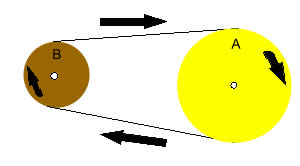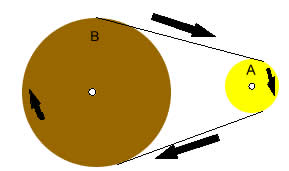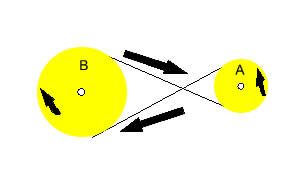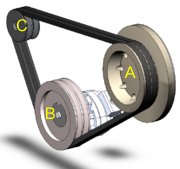Industrial revolution and the pulley
|
| The industrial revolution was possible due to the development of heavy machinery which automated production of goods. It freed workers from boring, laborious work but at the same time introduced a new element of danger as these huge machines generated incredibel forces and speeds. This level of automation made the manufacture of goods reliable and cheap. Force was transmitted to various parts of the machinery by pulleys connected to belts. |
| Huge boilers turned water into steam which was then used to generate force. |

A mobile boiler used to generated forces by boiling water into steam.
|
| Pulleys connected by belts transmitted the force throughout the factory to power machinery. Pulley systems could either multiply the speed or the force of machinery. |
|
| Suppose that the yellow pulley is connected to a steam engine. This pulley is known as the driver and drives the pulleys connected to it by belts. Since pulley B is smaller than pulley A it will rotate faster. This is a machine that acts as a speed multiplier. If pulley B is half the size of pulley A it should rotate at twice the speed. |

Speed multiplier |
| Pulley A (driver) is connected to a much larger pulley. This type of system will multiply the force that is produced by pulley A. If pulley B is twice as big as pulley A then it should be able to exert a force almost twice that of pulley A. |

Force multiplication |
| Pulleys can also change the direction of motion depending on how the belts are attached. |
 |
Look at the pulley system on the right. Pulley A and B are the same size while pulley C is a third the size of B .
Does pulley C rotate faster or slower than pulley A?
Describe the speed of pulley B as compared to pulley A?
If pulley A rotates clockwise describe the rotation of pulleys A and B.
Pulley A exerts a force measured at 10 units. What is the force exerted by pulley C and B? |
|
|
|
|





